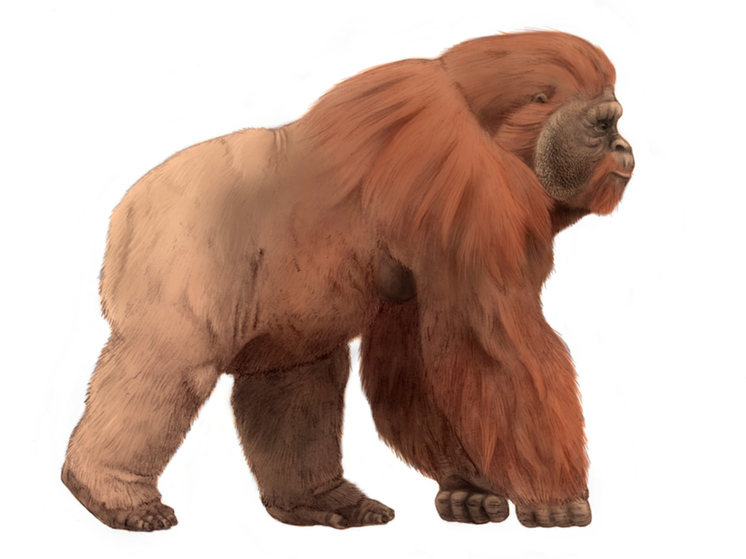Scientists are intrigued by extinct great apes
Giant apes resembling King Kong once roamed southern China. Scientists say they now know why and when these primates disappeared.

The largest known ape reached a height of approximately 3 meters and weighed almost twice as much as a gorilla. Why and when the legendary colossus that captured the popular imagination as the “real King Kong” disappeared is one of the biggest mysteries in paleontology, notes CNN.
German-Dutch paleontologist G.H.R. von Koenigswald first identified Gigantopithecus blacki about a hundred years ago from large teeth that were sold as medicinal “dragon bones.” in one of the pharmacies in Hong Kong. Since then, nearly 2,000 fossilized teeth and four jawbones from an extinct species have been discovered in caves in southern China.
Now new research into many of these rare fossils and the caves where they were found is based on preliminary evidence revealing chronology that sheds more light on the elusive circumstances surrounding the death of Gigantopithecus.
“I think the child in us wants to know about these amazing creatures and what happened to them”” said Renaud Joannes-Boillot, co-author of the study published Wednesday in the journal Nature and a professor in the Faculty of Science and Engineering at Southern Cross University in Australia.
The study authors believe this massive creature went extinct between 295,000 and 215 000 years ago, after the climate became more seasonal and the herbivorous primate struggled to adapt to changing vegetation.
Before Gigantopithecus populations declined due to climate change, the species thrived approximately 2 million years ago in a rich and diverse forest environment, feeding primarily on fruit, according to study co-author Kira Westaway, a professor and geochronologist at Macquarie University in Australia.
“About 700,000 or 600,000 years ago we began to notice significant changes in the environment, and during this period we saw a decline in the availability of fruits, “ she explained. – Gigantopithecus ate less nutritious reserve foods. We obtained evidence by studying the structure of teeth. The pits and scratches on the teeth indicate that it ate truly fibrous foods, such as bark and twigs from the forest floor.
For nearly a decade, a team of Chinese and Australian scientists took sediment samples from 22 caves in the vast Guangxi region of southern China, bordering Vietnam. Gigantopithecus fossils were found in half of the caves, and in half – no.
First, the researchers obtained precise dates for the fossils and sediments using several methods. Luminescence dating revealed when the sediment was last exposed to sunlight and deposited in the cave, and U-series dating pinpointed when the uranium entered the bone samples after the animal died. This analysis helped the team create a detailed chronology of the species' existence.
“Hundreds of teeth were found in early 2-million-year-old caves, but in later caves from the extinction period – only 3-4 teeth”, – says Kira Westaway.
The team then analyzed pollen traces in sediment samples to understand which plants and trees dominated the landscape. Isotope analysis of elements such as carbon and oxygen contained in Gigantopithecus teeth has helped researchers understand how the animal's diet may have changed over time.
Westaway said the team found that the giant ape was poorly adapted to changing environmental conditions, leading to chronic stress and population decline.
“We have a much more reliable chronology of their lives and when they became extinct, – Instead of relying on evidence from one or two caves, we sampled 22 caves over a wide area and used six dating methods to ensure the chronology was accurate, – she said.
Fossils of Gigantopithecus from the neck down have never been found or documented. Considering that Gigantopithecus roamed parts of Asia for about 2 million years, Westaway said this is surprising.
Giant apes never lived in caves, according to the authors. Rodents are believed to have carried the remains into them, often through small cracks in the rocks in the region's characteristic rocky-karst topography, said study co-author Wang Wei, a professor at the Institute of Cultural Heritage at Shandong University in Qingdao, China.
“The teeth or mandibles of apes (based on the fossil evidence found) went through an extremely complex process of death, decomposition, weathering, transport and sedimentation before they were buried in cave sediments, “ he explained. – As a result, only a very small number of the hardest body parts of Gigantopithecus could become fossils during geological history.
Given the lack of non-cranial fossils, it is difficult to say exactly what Gigantopithecus would have looked like. Its upper molars are 57.8% larger than those of a gorilla, and its lower ones – by 33%, suggesting that its body weight was between 200 and 300 kilograms.
The monkey's gigantic size indicates that it most likely lived on the ground, walking on its fists. Analysis of proteins found in Gigantopithecus fossils in November 2019 revealed that its closest living relative is the Bornean orangutan.
Homo erectus, an early human ancestor, is known to have lived in northern China and further south in Indonesia, at the same time that the giant ape lived in the forests of what is now southern China.
Professor Wang noted that in the Bose Basin, near the cave where the Gigantopithecus fossils were found, archaeologists discovered a large number of stone tools dating back approximately 800,000 years ago. Although scientists have no direct fossil evidence of the coexistence of H. erectus and the giant ape in the region, it is possible that these human ancestors may have had an encounter with «the big guy,» he said.


























































Свежие комментарии